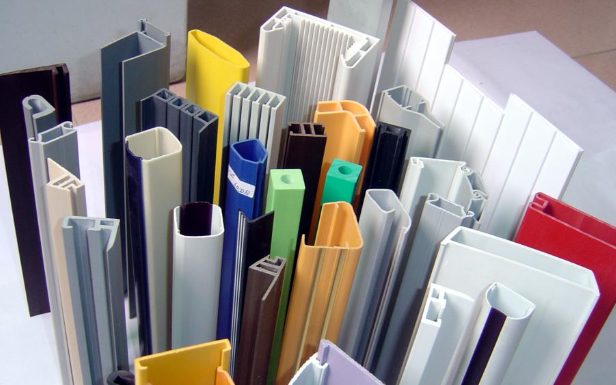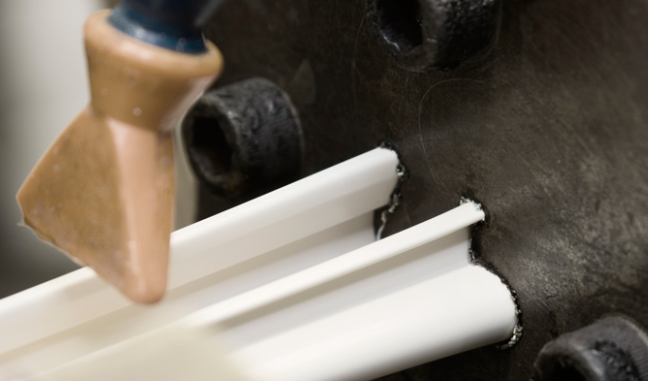Hot extrusion involves heating materials, offering versatility in shapes, while cold extrusion is performed at room temperature, providing better energy efficiency and precision.
Hot Extrusion
Hot extrusion, a widely used manufacturing process, involves forcing material through a die to create objects with a fixed cross-sectional profile. This process is ideal for producing a wide range of shapes and sizes, often used in the production of aluminum profiles and tubes.

Process Description
In hot extrusion, manufacturers heat the material above its recrystallization temperature. The process begins by preheating the metal billet to a specific temperature, typically ranging from 350°C to 500°C for aluminum, ensuring the material becomes malleable. The heated billet then gets placed in the extrusion press, where a hydraulic ram pushes it through the die. As the material passes through the die, it takes on the desired shape, emerging as an elongated piece with the cross-section of the die.
Materials Suitable for Hot Extrusion
Hot extrusion works best with metals that exhibit good ductility and malleability at elevated temperatures. Common materials include aluminum, copper, steel, and magnesium. Aluminum, in particular, is a popular choice due to its excellent extrudability and lightweight properties.
Advantages of Hot Extrusion
The primary advantage of hot extrusion is its ability to create complex cross-sections with excellent surface finish. The process allows for a high degree of material deformation, leading to finer grain structures and enhanced mechanical properties. Additionally, hot extrusion can handle larger billets, resulting in longer extrusion lengths and fewer joins in the final product.
Limitations and Challenges
Despite its benefits, hot extrusion faces several challenges. The high temperatures required for the process increase energy consumption, impacting overall efficiency and costs. Equipment maintenance is also more demanding due to the thermal stresses involved. Moreover, the process may introduce residual stresses and distortions in the final product, necessitating further treatments or precision machining to achieve the desired tolerances and specifications.
Cold Extrusion
Cold extrusion is a process where manufacturers deform metal at room temperature by forcing it through a die to achieve a desired shape. This technique is particularly effective for producing solid and hollow parts and is widely used in the automotive and electronics industries.
Process Description
In cold extrusion, the metal billet gets placed in a press without preheating. A hydraulic or mechanical press then applies high pressure, forcing the billet through a die. This process results in a product with the same cross-section as the die. The lack of heating means less energy consumption and a smaller environmental footprint compared to hot extrusion.
Materials Suitable for Cold Extrusion
Cold extrusion works well with metals like aluminum, copper, lead, steel, and tin. These materials exhibit sufficient ductility at room temperature, making them ideal for the cold extrusion process. Aluminum is particularly popular due to its lightweight and corrosion-resistant properties.
Advantages of Cold Extrusion
The major advantage of cold extrusion is its ability to produce parts with excellent mechanical properties, such as increased strength and hardness due to work hardening. The process also offers a superior surface finish and higher dimensional accuracy. Moreover, cold extrusion is more energy-efficient than hot extrusion, as it eliminates the need for heating, thus reducing energy costs.
Limitations and Challenges
The primary challenge in cold extrusion is the high tooling costs, as the process requires robust and durable dies to withstand the immense pressures. Additionally, the high forces involved limit the complexity of the shapes that can be produced. The process is also restricted to materials that can withstand deformation without heating, limiting the range of suitable materials.
Comparative Analysis of Hot and Cold Extrusion
The comparison between hot and cold extrusion processes involves various factors like temperature requirements, energy efficiency, material properties, and applications. The following table provides a detailed comparative analysis:
| Factor | Hot Extrusion | Cold Extrusion |
|---|---|---|
| Temperature and Energy Requirements | Requires high temperatures (350°C to 500°C for aluminum). Energy consumption is higher due to heating. | Operates at room temperature, leading to lower energy consumption. |
| Material Properties and Tolerances | Suitable for metals like aluminum, copper, and steel. Allows for greater material deformation, offering broader tolerances. | Best for ductile metals like aluminum and copper. Offers higher dimensional accuracy and tighter tolerances. |
| Surface Finish and Structural Integrity | Produces a good surface finish; however, may require additional treatments for precision. | Yields excellent surface finish and work-hardened structures with enhanced strength. |
| Applications and Use Cases | Ideal for complex shapes and larger sections like aluminum frames and tubes. | Suited for smaller, high-strength components like gears and fasteners in automotive and electronics. |
Temperature and Energy Requirements
Hot extrusion demands significant energy for heating materials, impacting overall costs and efficiency. In contrast, cold extrusion is more energy-efficient, reducing energy costs and enhancing sustainability.
Material Properties and Tolerances
Hot extrusion allows for a wider range of materials and tolerances, accommodating materials with less ductility. Cold extrusion, however, requires materials that can withstand high deformation forces at room temperature, resulting in higher quality and precision.
Surface Finish and Structural Integrity
Cold extrusion excels in providing superior surface finish and structural integrity. The work hardening in cold extrusion improves the strength and durability of the product, which is crucial for high-performance applications.
Applications and Use Cases
Hot extrusion is more versatile in terms of applications, suitable for larger and more complex profiles. Cold extrusion is ideal for mass-producing small to medium-sized parts that require high strength and precision, such as components in the automotive industry.
Technical Considerations in Hot and Cold Extrusion
When comparing hot and cold extrusion processes, it’s essential to consider various technical aspects, including equipment and machinery differences, die design variations, and process control and precision.
Equipment and Machinery Differences
- Hot Extrusion:
- Requires heavy-duty hydraulic presses capable of handling high temperatures.
- Presses typically have higher power ratings, often exceeding 10,000 kW, to manage the large billets and high temperatures.
- The machinery includes heating systems for billets, which add to the overall cost and energy consumption.
- Cold Extrusion:
- Utilizes mechanical or hydraulic presses that operate at room temperature.
- Power requirements are generally lower, around 5,000 kW, depending on the material and part size.
- The absence of heating equipment makes these machines more energy-efficient and reduces operational costs.
Die Design Variations
- Hot Extrusion:
- Dies must withstand high temperatures and thermal stresses.
- Often made from high-grade tool steels or tungsten carbide to ensure longevity and durability.
- Die design may include allowances for thermal expansion.
- Cold Extrusion:
- Requires extremely robust dies due to the high deformation forces at room temperature.
- Typically made from high-strength tool steels with specialized coatings to minimize wear.
- Die design focuses on precision and tight tolerances to ensure high quality and accuracy.
Process Control and Precision
- Hot Extrusion:
- Process control is challenging due to the high temperatures, affecting material properties.
- Precision in dimensions and tolerances can be harder to maintain, often requiring secondary machining.
- Suitable for applications where slightly lower precision is acceptable.
- Cold Extrusion:
- Offers superior control over the process, resulting in higher precision and consistency.
- Better dimensional accuracy and surface finish, reducing or eliminating the need for secondary operations.
- Ideal for producing parts with strict tolerance requirements and high quality standards.

Environmental and Economic Aspects of Extrusion Processes
The environmental and economic aspects of extrusion processes, such as energy efficiency, waste management, and cost implications, play a crucial role in determining their sustainability and market viability.
Energy Efficiency and Consumption
- Hot Extrusion:
- Energy Consumption: High due to the need for heating materials. Average power usage can range from 10,000 kW to 20,000 kW.
- Efficiency: Less energy-efficient due to additional heating requirements.
- Cold Extrusion:
- Energy Consumption: Lower, as it operates at room temperature. Power requirements are typically between 5,000 kW and 10,000 kW.
- Efficiency: More energy-efficient, reducing operational costs and environmental impact.
Waste Management and Recycling
- Both Hot and Cold Extrusion:
- Waste Production: Generate minimal waste due to the nature of the process.
- Recycling: High potential for recycling scrap material, further reducing environmental impact.
- Material Utilization: Both processes are efficient in material usage, but cold extrusion offers slightly better material conservation due to tighter control over the process.
Cost Implications and Market Trends
Hot Extrusion:
Cost Factors: Higher operational costs due to energy consumption and maintenance of high-temperature equipment.
Market Trends: Continues to be popular for large-scale industrial applications despite higher costs, due to its versatility in handling a wide range of materials and shapes.
Cold Extrusion:
Cost Factors: Lower operational costs, but higher initial investment in robust tooling.
Market Trends: Gaining popularity in sectors like automotive and electronics, where precision and strength are paramount.




